Aspects of Spodumene Lithium Extraction Techniques
Abstract
:1. Introduction
2. Lithium Recovery from Spodumene
2.1. Acid Methods
2.1.1. Sulfuric Acid
2.1.2. Hydrofluoric Acid (HF)
2.1.3. Nitric Acid
2.1.4. Hydrochloric Acid
2.2. Chlorinating Method
2.2.1. Chlorine Gas
2.2.2. Chloride Routes
2.3. Carbonate Roasting and Autoclaving Method
2.4. Alkali Methods
Alkaline Hydrothermal Treatment
2.5. Sulfate Roasting
2.6. Microwave-Assisted Processing
2.6.1. MW Heating Mechanisms
2.6.2. Microwave-Assisted Decrepitation and Li Extraction
2.7. Mechanical Activation
3. Recycling Lithium and Other Precious Metals from Spent LIBs
4. Summary, Challenges, and Outlook
Author Contributions
Funding
Data Availability Statement
Acknowledgments
Conflicts of Interest
References
- Hart, W.A.; Beumel, O.; Whaley, T.P. The chemistry of Lithium. Sodium, Potassium, Rubidium, Cesium and Francium; Pergmum Press: New York, NY, USA; Oxford, UK, 1973; Volume 13. [Google Scholar]
- Christmann, P.; Gloaguen, E.; Labbé, J.-F.; Melleton, J.; Piantone, P. Global lithium resources and sustainability issues. In Lithium Process Chemistry; Elsevier: Amsterdam, The Netherlands, 2015; pp. 1–40. [Google Scholar]
- Nandihalli, N. A Review of Nanocarbon-Based Anode Materials for Lithium-Ion Batteries. Crystals 2024, 14, 800. [Google Scholar] [CrossRef]
- Gao, Z.; Xie, H.; Yang, X.; Zhang, L.; Yu, H.; Wang, W.; Liu, Y.; Xu, Y.; Ma, B.; Liu, X. Electric vehicle lifecycle carbon emission reduction: A review. Carbon Neutralization 2023, 2, 528–550. [Google Scholar] [CrossRef]
- Demin, S.V.; Zhilov, V.I.; Tsivadze, A. Lithium and boron isotope effects in extraction systems. Russ. J. Inorg. Chem. 2015, 60, 633–637. [Google Scholar] [CrossRef]
- Sheng, B.; Su, H.; Yu, J.; Lin, S. Lithium extraction process from low grade Na+/K+ brines dependent on high layer charge layered double hydroxides. Desalination 2023, 565, 116856. [Google Scholar] [CrossRef]
- Kamienski, C.W.; McDonald, D.P.; Stark, M.W.; Papcun, J.R. Lithium and lithium compounds. In Kirk-Othmer Encyclopedia of Chemical Technology; Wiley: Hoboken, NJ, USA, 2000. [Google Scholar]
- Tran, T.; Luong, V.T. Lithium production processes. In Lithium Process Chemistry; Elsevier: Amsterdam, The Netherlands, 2015; pp. 81–124. [Google Scholar]
- Vera, M.L.; Torres, W.R.; Galli, C.I.; Chagnes, A.; Flexer, V. Environmental impact of direct lithium extraction from brines. Nat. Rev. Earth Environ. 2023, 4, 149–165. [Google Scholar] [CrossRef]
- Ash, S. Mineral Commodity Summaries 2019; US Geological Survey: Reston, VA, USA, 2019.
- Rosales, G.D.; del Carmen Ruiz, M.; Rodriguez, M.H. Novel process for the extraction of lithium from β-spodumene by leaching with HF. Hydrometallurgy 2014, 147, 1–6. [Google Scholar] [CrossRef]
- Meshram, P.; Pandey, B.D.; Mankhand, T.R. Extraction of lithium from primary and secondary sources by pre-treatment, leaching and separation: A comprehensive review. Hydrometallurgy 2014, 150, 192–208. [Google Scholar] [CrossRef]
- Garrett, D.E. Handbook of Lithium and Natural Calcium Chloride: Their Deposits, Processing, Uses and Properties, 1st ed.; Elsevier: Amsterdam, The Netherlands, 2004. [Google Scholar]
- Labbé, J.-F.; Daw, G. Panorama 2011 du Marché du Lithium. Bureau de Recherches Géologiques et Minières [BRGM]; Centre d’Economie de la Sorbonne [CES]. 2012. Available online: https://shs.hal.science/halshs-00809298/ (accessed on 26 September 2024).
- Li, C.-T.; Peacor, D.R. The crystal structure of LiAlSi2O6-II (“β spodumene”). Z. Für Krist.-Cryst. Mater. 1968, 126, 46–65. [Google Scholar] [CrossRef]
- Peltosaari, O.; Tanskanen, P.; Heikkinen, E.P.; Fabritius, T. α→ γ→ β-phase transformation of spodumene with hybrid microwave and conventional furnaces. Miner. Eng. 2015, 82, 54–60. [Google Scholar] [CrossRef]
- Salakjani, N.K.; Singh, P.; Nikoloski, A.N. Production of lithium–A literature review. Part 2. Extraction from spodumene. Miner. Process. Extr. Metall. Rev. 2019, 42, 268–283. [Google Scholar] [CrossRef]
- Fasshauer, D.W.; Chatterjee, N.D.; Cemic, L. A thermodynamic analysis of the system LiAlSiO4-NaAlSiO4-Al2O3-SiO2-H2O based on new heat capacity, thermal expansion, and compressibility data for selected phases. Contrib. Mineral. Petrol. 1998, 133, 186–198. [Google Scholar] [CrossRef]
- Choubey, P.K.; Kim, M.S.; Srivastava, R.R.; Lee, J.-c.; Lee, J.Y. Advance review on the exploitation of the prominent energy-storage element: Lithium. Part I: From mineral and brine resources. Miner. Eng. 2016, 89, 119–137. [Google Scholar] [CrossRef]
- Barbosa, L.I.; Valente, G.; Orosco, R.P.; Gonzalez, J.A. Lithium extraction from β-spodumene through chlorination with chlorine gas. Miner. Eng. 2014, 56, 29–34. [Google Scholar] [CrossRef]
- Li, H.; Eksteen, J.; Kuang, G. Recovery of lithium from mineral resources: State-of-the-art and perspectives–A review. Hydrometallurgy 2019, 189, 105129. [Google Scholar] [CrossRef]
- Karrech, A.; Azadi, M.R.; Elchalakani, M.; Shahin, M.A.; Seibi, A.C. A review on methods for liberating lithium from pegmatities. Miner. Eng. 2020, 145, 106085. [Google Scholar] [CrossRef]
- Dessemond, C.; Soucy, G.; Harvey, J.-P.; Ouzilleau, P. Phase Transitions in the α–γ–β Spodumene Thermodynamic System and Impact of γ-Spodumene on the Efficiency of Lithium Extraction by Acid Leaching. Minerals 2020, 10, 519. [Google Scholar] [CrossRef]
- Peltosaari, O.; Tanskanen, P.; Hautala, S.; Heikkinen, E.P.; Fabritius, T. Mechanical enrichment of converted spodumene by selective sieving. Miner. Eng. 2016, 98, 30–39. [Google Scholar] [CrossRef]
- Kaunda, R.B. Potential environmental impacts of lithium mining. J. Energy Nat. Resour. Law 2020, 38, 237–244. [Google Scholar] [CrossRef]
- Graham, J.D.; Rupp, J.A.; Brungard, E. Lithium in the green energy transition: The quest for both sustainability and security. Sustainability 2021, 13, 11274. [Google Scholar] [CrossRef]
- Hu, Z.; Gao, S.; Liu, Y.; Hu, S.; Zhao, L.; Li, Y.; Wang, Q. NH 4 F assisted high pressure digestion of geological samples for multi-element analysis by ICP-MS. J. Anal. At. Spectrom. 2010, 25, 408–413. [Google Scholar] [CrossRef]
- Zhang, W.; Hu, Z. Recent advances in sample preparation methods for elemental and isotopic analysis of geological samples. Spectrochim. Acta Part B At. Spectrosc. 2019, 160, 105690. [Google Scholar] [CrossRef]
- Richter, R.C.; Nóbrega, J.A.; Pirola, C. Think Blank: Clean Chemistry Tools for Atomic Spectroscopy; IKONOS srl: Rome, Italy, 2016. [Google Scholar]
- Mariet, C.; Belhadj, O.; Leroy, S.; Carrot, F.; Métrich, N. Relevance of NH4F in acid digestion before ICP-MS analysis. Talanta 2008, 77, 445–450. [Google Scholar] [CrossRef] [PubMed]
- Zhang, N.; Gao, X.; Shen, Y.; Wang, C.; Wang, J. Effects of ammonium fluoride on the decomposition of geochemical samples as fluorinating agent and its analytical application. Anal. Sci. 2013, 29, 441–446. [Google Scholar] [CrossRef] [PubMed]
- Ammann, A.A. Inductively coupled plasma mass spectrometry (ICP MS): A versatile tool. J. Mass Spectrom. 2007, 42, 419–427. [Google Scholar] [CrossRef]
- Freiser, H. Ion-Selective Electrodes in Analytical Chemistry; Springer Science & Business Media: Berlin/Heidelberg, Germany, 2012. [Google Scholar]
- Murphy, K.R.; Stedmon, C.A.; Graeber, D.; Bro, R. Fluorescence spectroscopy and multi-way techniques. PARAFAC. Anal. Methods 2013, 5, 6557–6566. [Google Scholar] [CrossRef]
- Chauhan, A.; Chauhan, P. Powder XRD technique and its applications in science and technology. J. Anal. Bioanal. Tech. 2014, 5, 5. [Google Scholar] [CrossRef]
- Wilde, A.; Otto, A.; McCracken, S. Geology of the Goulamina spodumene pegmatite field, Mali. Ore Geol. Rev. 2021, 134, 104162. [Google Scholar] [CrossRef]
- Volpi, M.; Pirola, C.; Rota, G.; Nóbrega, J.A.; Carnaroglio, D. Microwave-assisted sample preparation of α-spodumene: A simple procedure for analysis of a complex sample. Miner. Eng. 2022, 187, 107820. [Google Scholar] [CrossRef]
- Bale, M.D.; May, A.V. Processing of ores to produce tantalum and lithium. Miner. Eng. 1989, 2, 299–320. [Google Scholar] [CrossRef]
- Amarante, M.; De Sousa, A.B.; Leite, M.M. Processing a spodumene ore to obtain lithium concentrates for addition to glass and ceramic bodies. Miner. Eng. 1999, 12, 433–436. [Google Scholar] [CrossRef]
- Li, Y.; Cheng, G.; Zhang, M.; Cao, Y.; Von Lau, E. Advances in depressants used for pyrite flotation separation from coal/minerals. Int. J. Coal Sci. Technol. 2022, 9, 54. [Google Scholar] [CrossRef]
- Tadesse, B.; Makuei, F.; Albijanic, B.; Dyer, L. The beneficiation of lithium minerals from hard rock ores: A review. Miner. Eng. 2019, 131, 170–184. [Google Scholar] [CrossRef]
- Cheng, G.; Xiong, L.; Lu, Y.; Zhang, Z.G.; Lv, C.; Lau, E.V. Advancements in the application of surface roughness in mineral flotation process. Sep. Sci. Technol. 2024, 59, 592–611. [Google Scholar] [CrossRef]
- Mingshun, X.; Shiheng, W.; Qinfang, Z. Leaching mechanism of the spodumene sulphuric acid process. Rare Met. (Engl. Ed.) 1997, 16, 36–44. [Google Scholar]
- Tian, Q.; Chen, B.; Chen, Y.; Ma, L.; Shi, X. Roasting and leaching behavior of spodumene in sulphuric acid process. Xiyou Jinshu/Chin. J. Rare Met. 2011, 35, 118–123. [Google Scholar]
- Kuang, G.; Chen, Z.B.; Guo, H.; Li, M.H. Lithium extraction mechanism from α-spodumene by fluorine chemical method. Adv. Mater. Res. 2012, 524, 2011–2016. [Google Scholar] [CrossRef]
- Rosales, G.D.; del Carmen Ruiz, M.; Rodriguez, M.H. Alkaline metal fluoride synthesis as a subproduct of β-spodumene leaching. Hydrometallurgy 2013, 139, 73–78. [Google Scholar] [CrossRef]
- Guo, H.; Kuang, G.; Wang, H.; Yu, H.; Zhao, X. Investigation of enhanced leaching of lithium from α-spodumene using hydrofluoric and sulfuric acid. Minerals 2017, 7, 205. [Google Scholar] [CrossRef]
- Hunwick, R. Recovery of Lithium from Silicate Minerals. U.S. Patent US2017017522, 12 December 2016. [Google Scholar]
- Sharma, Y. Processing of Lithium Containing Ore; 2014; Available online: https://patents.google.com/patent/US20150152523A1/en (accessed on 26 September 2024).
- Margarido, F.; Vieceli, N.; Durão, F.; Guimarães, C.; Nogueira, C. Minero-metallurgical processes for lithium recovery from pegmatitic ores= Processos minero-metalúrgicos para a recuperação de lítio de minérios pegmatíticos. Comun. Geológicas 2014, 101, 795–798. [Google Scholar]
- Fosu, A.Y.; Kanari, N.; Bartier, D.; Vaughan, J.; Chagnes, A. Novel extraction route of lithium from α-spodumene by dry chlorination. RSC Adv. 2022, 12, 21468–21481. [Google Scholar] [CrossRef]
- Jena, P.K.; Brocchi, E.A. Metal extraction through chlorine metallurgy. Miner. Process. Extr. Metall. Rev. 1997, 16, 211–237. [Google Scholar] [CrossRef]
- Liu, J.; Wen, S.-m.; Chen, Y.; Liu, D.; Bai, S.-j.; Wu, D.-d. Process optimization and reaction mechanism of removing copper from an Fe-rich pyrite cinder using chlorination roasting. J. Iron. Steel Res. Int. 2013, 20, 20–26. [Google Scholar] [CrossRef]
- Barbosa, L.I.; González, J.A.; del Carmen Ruiz, M. Extraction of lithium from β-spodumene using chlorination roasting with calcium chloride. Thermochim. Acta 2015, 605, 63–67. [Google Scholar] [CrossRef]
- Gabra, G.G.; Torma, A.E.; Olivier, C.A. Pressure leaching of beta-spodumene by sodium chloride. Can. Metall. Q. 1975, 14, 355–359. [Google Scholar] [CrossRef]
- Medina, L.F.; El-Naggar, M. An alternative method for the recovery of lithium from spodumene. Metall. Trans. B 1984, 15, 4. [Google Scholar] [CrossRef]
- Chen, Y.; Tian, Q.; Chen, B.; Shi, X.; Liao, T. Preparation of lithium carbonate from spodumene by a sodium carbonate autoclave process. Hydrometallurgy 2011, 109, 43–46. [Google Scholar] [CrossRef]
- Tiihonen, M.; Haavanlammi, L.; Kinnunen, S.; Kolehmainen, E. Outotec lithium hydroxide process-a novel direct leach process for the production of battery grade lithium hydroxide monohydrate form calcined spodumene. In Proceedings of the ALTA 2019, Sydney, Australia, 4–6 December 2019; ALTA Metallurgical Services: Perth, Australia, 2019. [Google Scholar]
- Zhou, H.; Cao, Z.; Ma, B.; Wang, C.; Chen, Y. Selective and efficient extraction of lithium from spodumene via nitric acid pressure leaching. Chem. Eng. Sci. 2024, 287, 119736. [Google Scholar] [CrossRef]
- Wang, S.; Szymanski, N.J.; Fei, Y.; Dong, W.; Christensen, J.N.; Zeng, Y.; Whittaker, M.; Ceder, G. Direct Lithium Extraction from α-Spodumene through Solid-State Reactions for Sustainable Li2CO3 Production. Inorg. Chem. 2024, 63, 13576–13584. [Google Scholar] [CrossRef]
- Xing, P.; Wang, C.; Zeng, L.; Ma, B.; Wang, L.; Chen, Y.; Yang, C. Lithium extraction and hydroxysodalite zeolite synthesis by hydrothermal conversion of α-spodumene. ACS Sustain. Chem. Eng. 2019, 7, 9498–9505. [Google Scholar] [CrossRef]
- Qiu, S.; Liu, C.; Yu, J. Conversion from α-spodumene to intermediate product Li2SiO3 by hydrothermal alkaline treatment in the lithium extraction process. Miner. Eng. 2022, 183, 107599. [Google Scholar] [CrossRef]
- Qiu, S.; Zhu, Y.; Jiang, Y.; Liu, C.; Yu, J. Kinetics and Mechanism of Lithium Extraction from α-Spodumene in Potassium Hydroxide Solution. Ind. Eng. Chem. Res. 2022, 61, 15103–15113. [Google Scholar] [CrossRef]
- Song, Y.; Zhao, T.; He, L.; Zhao, Z.; Liu, X. A promising approach for directly extracting lithium from α-spodumene by alkaline digestion and precipitation as phosphate. Hydrometallurgy 2019, 189, 105141. [Google Scholar] [CrossRef]
- Han, S.; Sagzhanov, D.; Pan, J.; Vaziri Hassas, B.; Rezaee, M.; Akbari, H.; Mensah-Biney, R. Direct Extraction of Lithium from α-Spodumene by Salt Roasting–Leaching Process. ACS Sustain. Chem. Eng. 2022, 10, 13495–13504. [Google Scholar] [CrossRef]
- Zhou, H.; Liu, Y.; Ma, B.; Wang, C.; Chen, Y. Strengthening extraction of lithium and rubidium from activated α-spodumene concentrate via sodium carbonate roasting. J. Ind. Eng. Chem. 2023, 123, 248–259. [Google Scholar] [CrossRef]
- Braga, P.; França, S.; Neumann, R.; Rodriguez, M.; Rosales, G. Alkaline process for extracting lithium from Spodumene. In Proceedings of the 11th International Seminar on Process Hydrometallurgy-Hydroprocess, Santiago, Chile, 19–21 June 2019; pp. 19–21. [Google Scholar]
- Maurice, A.; Olivier, C.A. Carbonatizing Roast of Lithiumbearing Ores. U.S. Patent US3380802A, 30 April 1968. [Google Scholar]
- McIntosh, N.C. Production of Lithium Compounds. U.S. Patent US2413644A, 27 February 1943. [Google Scholar]
- Zhang, Y.; Ma, B.; Lv, Y.; Wang, C.; Chen, Y. An effective method for directly extracting lithium from α-spodumene by activated roasting and sulfuric acid leaching. J. Ind. Eng. Chem. 2023, 122, 540–550. [Google Scholar] [CrossRef]
- Lee, D.; Joo, Y.-Y.; Shin, D.J.; Shin, S.M. Recovery of Lithium from Beta-Spodumene Through Serial Calcination and Water Leaching with CaO. JOM 2024, 76, 1477–1484. [Google Scholar] [CrossRef]
- Zelikman, A.N.; Krein, O.E.; Samsonov, G.V. Metallurgy of Rare Metals; Isreal Program for Scientific Translations: Jarusalem, Isreal, 1966. [Google Scholar]
- Kuang, G.; Liu, Y.; Li, H.; Xing, S.; Li, F.; Guo, H. Extraction of lithium from β-spodumene using sodium sulfate solution. Hydrometallurgy 2018, 177, 49–56. [Google Scholar] [CrossRef]
- Ncube, T.; Oskierski, H.; Senanayake, G.; Dlugogorski, B.Z. Two-step reaction mechanism of roasting spodumene with potassium sulfate. Inorg. Chem. 2021, 60, 3620–3625. [Google Scholar] [CrossRef]
- Suharyanto, A.; Lalasari, L.H.; Mubarok, M.Z. Decomposition of spodumene mineral in granitic rocks from South Kalimantan-Indonesia by potassium sulphate. In IOP Conference Series: Materials Science and Engineering; IOP Publishing: Bristol, UK, 2019; p. 012044. [Google Scholar]
- Laferrière, A.; Dessureault, Y.; Skiadas, N.; Gary, H.K.; Pearse, A.L. NI 43-101 Technical Report: Preliminary Economic Assessment of the Whabouchi Lithium Deposit and Hydromet Plant; Nemaska Lithium Inc.: Montreal, AC, Canada, 2012. [Google Scholar]
- Archarnhault, M.Q.; Quebec, A.O.C. Carbonatizing Roast of Lithium Bearing Ores. U.S. Patent 3380802, 30 April 1968. [Google Scholar]
- Peterson, J.A.; Gloss, G.H. Lithium Values Recovery Process. U.S. Patent 2893828, 7 July 1959. [Google Scholar]
- Erasmus, H.D.W. Method of Treating Lithiferous Ores to Recover Lithium as Lithium Chloride. U.S. Patent 2561439, 24 July 1951. [Google Scholar]
- Zelikman, A.N.; Krein, O.E.; Sansonov, G.V. Metallurgy of Rare Metals ((Translated from Russian) 458; NASA and National Science Foundation: Washington, DC, USA, 1966.
- Victor, K.A. Method of Recovering Lithium Compounds from Lithium Minerals. US Patent 2662809, 15 December 1953. [Google Scholar]
- Hayes, E.T.; Williams, F.P.; Sternberg, W.M. Production of Lithium Chloride from Spodumene. U.S. Patent 2533246, 12 December 1950. [Google Scholar]
- Rosales, G.D.; Resentera, A.C.; Gonzalez, J.A.; Wuilloud, R.G.; Rodriguez, M.H. Efficient extraction of lithium from β-spodumene by direct roasting with NaF and leaching. Chem. Eng. Res. Des. 2019, 150, 320–326. [Google Scholar] [CrossRef]
- Hui, G.; Yu, H.z.; Zhou, A.; LÜ, M.H.; Qiao, W.; Kuang, G.; Wang, H.D. Kinetics of leaching lithium from α-spodumene in enhanced acid treatment using HF/H2SO4 as medium. Trans. Nonferrous Met. Soc. China 2019, 29, 407–415. [Google Scholar] [CrossRef]
- Mishra, R.R.; Sharma, A.K. Microwave–material interaction phenomena: Heating mechanisms, challenges and opportunities in material processing. Compos. Part A 2016, 81, 78–97. [Google Scholar] [CrossRef]
- Mishra, R.R.; Sharma, A.K. A review of research trends in microwave processing of metal-based materials and opportunities in microwave metal casting. Crit. Rev. Solid State Mater. Sci. 2016, 41, 217–255. [Google Scholar] [CrossRef]
- Nandihalli, N.; Gregory, D.H.; Mori, T. Energy-Saving Pathways for Thermoelectric Nanomaterial Synthesis: Hydrothermal/Solvothermal, Microwave-Assisted, Solution-Based, and Powder Processing. Adv. Sci. 2022, 9, 2106052. [Google Scholar] [CrossRef]
- Rao, K.J.; Vaidhyanathan, B.; Ganguli, M.; Ramakrishnan, P.A. Synthesis of inorganic solids using microwaves. Chem. Mater. 1999, 11, 882–895. [Google Scholar] [CrossRef]
- Antonucci, V.; Correa, C. Sulfuric Acid Leaching of Chalcopyrite Concentrate Assisted by Application of Microwave Energy, Paper from COPPER 95, Volume III, Electrorefining and Hydrometallurgy of Copper. In Proceedings of the International Conference, Santiago, Chile, 26–29 November 1995; pp. 549–557. [Google Scholar]
- Beard, G.; Belcher, W.; Bradhurst, D.; Worner, H.; Cook, J. Microwave-Assisted Smelting of Rare-Earth Magnet Alloys. In Proceedings of the Twelfth International Workshop on Rare-Earth Magnets and Their Applications, Canberra, Australia, 12–15 July 1992; pp. 665–669. [Google Scholar]
- Yixin, L.C.X.Y.H. Application of microwave radiation to extractive metallurgy. J. Mater. Sci. Technol. 1990, 6, 121. [Google Scholar]
- Gomez, I.; Aguilar, J.A. Microwaves for reduction of iron ore pellet by carbon. MRS Online Proc. Libr. 1994, 366, 347. [Google Scholar] [CrossRef]
- Salakjani, N.K.; Nikoloski, A.N.; Singh, P. Mineralogical transformations of spodumene concentrate from Greenbushes, Western Australia. Part 2: Microwave heating. Miner. Eng. 2017, 100, 191–199. [Google Scholar] [CrossRef]
- Salakjani, N.K.; Singh, P.; Nikoloski, A.N. Acid roasting of spodumene: Microwave vs. conventional heating. Miner. Eng. 2019, 138, 161–167. [Google Scholar] [CrossRef]
- Rezaee, M.; Han, S.; Sagzhanov, D.; Hassas, B.V.; Slawecki, T.M.; Agrawal, D.; Akbari, H.; Mensah-Biney, R. Microwave-assisted calcination of spodumene for efficient, low-cost and environmentally friendly extraction of lithium. Powder Technol. 2022, 397, 116992. [Google Scholar] [CrossRef]
- Krivolapova, O.N.; Fureev, I.L. Application of microwave radiation for decrepitation of spodumene from the Kolmozerskoe deposit. Non-Ferr. Metall. 2023, 29, 5–12. [Google Scholar] [CrossRef]
- Luong, V.T.; Kang, D.J.; An, J.W.; Kim, M.J.; Tran, T. Factors affecting the extraction of lithium from lepidolite. Hydrometallurgy 2013, 134, 54–61. [Google Scholar] [CrossRef]
- Alex, T.C.; Kumar, R.; Roy, S.K.; Mehrotra, S.P. Mechanical activation of Al-oxyhydroxide minerals–A review. Miner. Process. Extr. Metall. Rev. 2016, 37, 1–26. [Google Scholar] [CrossRef]
- Kotsupalo, N.P.; Menzheres, L.T.; Ryabtsev, A.D.; Boldyrev, V.V. Mechanical activation of α-spodumene for further processing into lithium compounds. Theor. Found. Chem. Eng. 2010, 44, 503–507. [Google Scholar] [CrossRef]
- Necke, T.; Stein, J.; Kleebe, H.-J.; Balke-Grünewald, B. Lithium Extraction and Zeolite Synthesis via Mechanochemical Treatment of the Silicate Minerals Lepidolite, Spodumene, and Petalite. Minerals 2023, 13, 1030. [Google Scholar] [CrossRef]
- Gasalla, H.J.; Aglietti, E.F.; Lopez, J.M.P.; Pereira, E. Changes in physicochemical properties of α-spodumene by mechanochemical treatment. Mater. Chem. Phys. 1987, 17, 379–389. [Google Scholar] [CrossRef]
- Berger, A.; Boldyrev, V.; Menzheres, L. Mechanical activation of β-spodumene. Mater. Chem. Phys. 1990, 25, 339–350. [Google Scholar] [CrossRef]
- Rosales, G.D.; Resentera, A.C.J.; Wuilloud, R.G.; Rodriguez, M.H.; Esquivel, M.R. Optimization of combined mechanical activation-leaching parameters of low-grade α-spodumene/NaF mixture using response surface methodology. Miner. Eng. 2022, 184, 107633. [Google Scholar] [CrossRef]
- Dobó, Z.; Dinh, T.; Kulcsár, T. A review on recycling of spent lithium-ion batteries. Energy Rep. 2023, 9, 6362–6395. [Google Scholar] [CrossRef]
- Tawonezvi, T.; Nomnqa, M.; Petrik, L.; Bladergroen, B.J. Recovery and recycling of valuable metals from spent lithium-ion batteries: A comprehensive review and analysis. Energies 2023, 16, 1365. [Google Scholar] [CrossRef]
- Krishnan, R.; Gopan, G. A Comprehensive Review of Lithium Extraction: From Historical Perspectives to Emerging Technologies, Storage, and Environmental Considerations. Cleaner Eng. Technol. 2024, 20, 100749. [Google Scholar] [CrossRef]
- Ren, L.; Liu, B.; Bao, S.; Ding, W.; Zhang, Y.; Hou, X.; Lin, C.; Chen, B. Recovery of Li, Ni, Co and Mn from spent lithium-ion batteries assisted by organic acids: Process optimization and leaching mechanism. Int. J. Miner. Metall. Mater. 2024, 31, 518–530. [Google Scholar] [CrossRef]
- Yao, Y.; Zhu, M.; Zhao, Z.; Tong, B.; Fan, Y.; Hua, Z. Hydrometallurgical processes for recycling spent lithium-ion batteries: A critical review. ACS Sustain. Chem. Eng. 2018, 6, 13611–13627. [Google Scholar] [CrossRef]
- Peng, Q.; Zhu, X.; Li, J.; Liao, Q.; Lai, Y.; Zhang, L.; Fu, Q.; Zhu, X. A novel method for carbon removal and valuable metal recovery by incorporating steam into the reduction-roasting process of spent lithium-ion batteries. Waste Manag. 2021, 134, 100–109. [Google Scholar] [CrossRef]
- Yang, C.; Zhang, J.; Yu, B.; Huang, H.; Chen, Y.; Wang, C. Recovery of valuable metals from spent LiNixCoyMnZO2 cathode material via phase transformation and stepwise leaching. Sep. Purif. Technol. 2021, 267, 118609. [Google Scholar] [CrossRef]
- Lin, J.; Li, L.; Fan, E.; Liu, C.; Zhang, X.; Cao, H.; Sun, Z.; Chen, R. Conversion mechanisms of selective extraction of lithium from spent lithium-ion batteries by sulfation roasting. ACS Appl. Mater. Interfaces 2020, 12, 18482–18489. [Google Scholar] [CrossRef]
- Makuza, B.; Yu, D.; Huang, Z.; Tian, Q.; Guo, X. Dry grinding-carbonated ultrasound-assisted water leaching of carbothermally reduced lithium-ion battery black mass towards enhanced selective extraction of lithium and recovery of high-value metals. Resour. Conserv. Recycl. 2021, 174, 105784. [Google Scholar] [CrossRef]
- Pinegar, H.; Smith, Y.R. Recycling of end-of-life lithium ion batteries, Part I: Commercial processes. J. Sustain. Metall. 2019, 5, 402–416. [Google Scholar] [CrossRef]
- Ding, W.; Bao, S.; Zhang, Y.; Ren, L.; Xin, C.; Chen, B.; Liu, B.; Xiao, J.; Hou, X. Stepwise recycling of valuable metals from spent lithium-ion batteries based on in situ thermal reduction and ultrasonic-assisted water leaching. Green Chem. 2023, 25, 6652–6665. [Google Scholar] [CrossRef]
- Takacova, Z.; Orac, D.; Klimko, J.; Miskufova, A. Current trends in spent portable lithium battery recycling. Materials 2023, 16, 4264. [Google Scholar] [CrossRef] [PubMed]
- Chen, W.-S.; Ho, H.-J. Recovery of valuable metals from lithium-ion batteries NMC cathode waste materials by hydrometallurgical methods. Metals 2018, 8, 321. [Google Scholar] [CrossRef]
- Zhang, G.; Du, Z.; He, Y.; Wang, H.; Xie, W.; Zhang, T. A sustainable process for the recovery of anode and cathode materials derived from spent lithium-ion batteries. Sustainability 2019, 11, 2363. [Google Scholar] [CrossRef]
- Klimko, J.; Oráč, D.; Miškufová, A.; Vonderstein, C.; Dertmann, C.; Sommerfeld, M.; Friedrich, B.; Havlík, T. A combined pyro-and hydrometallurgical approach to recycle pyrolyzed lithium-ion battery black mass part 2: Lithium recovery from Li enriched slag—Thermodynamic study, kinetic study, and dry digestion. Metals 2020, 10, 1558. [Google Scholar] [CrossRef]
- Peng, C.; Liu, F.; Aji, A.T.; Wilson, B.P.; Lundström, M. Extraction of Li and Co from industrially produced Li-ion battery waste–Using the reductive power of waste itself. Waste Manag. 2019, 95, 604–611. [Google Scholar] [CrossRef] [PubMed]
- Chen, X.; Cao, L.; Kang, D.; Li, J.; Zhou, T.; Ma, H. Recovery of valuable metals from mixed types of spent lithium ion batteries. Part II: Selective extraction of lithium. Waste Manag. 2018, 80, 198–210. [Google Scholar] [CrossRef] [PubMed]
- Tang, Y.C.; Wang, J.Z.; Shen, Y.H. Separation of valuable metals in the recycling of lithium batteries via solvent extraction. Minerals 2023, 13, 285. [Google Scholar] [CrossRef]
- Garcia, L.V.; Ho, Y.-C.; Myo Thant, M.M.; Han, D.S.; Lim, J.W. Lithium in a sustainable circular economy: A comprehensive review. Processes 2023, 11, 418. [Google Scholar] [CrossRef]
- Zanoletti, A.; Carena, E.; Ferrara, C.; Bontempi, E. A Review of Lithium-Ion Battery Recycling: Technologies, Sustainability, and Open Issues. Batteries 2024, 10, 38. [Google Scholar] [CrossRef]
- Gerold, E.; Luidold, S.; Antrekowitsch, H. Separation and efficient recovery of lithium from spent lithium-ion batteries. Metals 2021, 11, 1091. [Google Scholar] [CrossRef]
- Marchese, D.; Giosuè, C.; Staffolani, A.; Conti, M.; Orcioni, S.; Soavi, F.; Cavalletti, M.; Stipa, P. An overview of the sustainable recycling processes used for lithium-ion batteries. Batteries 2024, 10, 27. [Google Scholar] [CrossRef]
- Rautela, R.; Yadav, B.R.; Kumar, S. A review on technologies for recovery of metals from waste lithium-ion batteries. J. Power Sources 2023, 580, 233428. [Google Scholar] [CrossRef]
- Tiihonen, M. Method of Extracting Lithium Compound (s). U.S. Patent US20210147247A1, 20 May 2021. [Google Scholar]
- Tiihonen, M.; Haavanlammi, L. Method for Recovering Lithium Carbonate. U.S. Patent US9255012B2, 9 February 2016. [Google Scholar]
- Kiggins, C.; Cook, J.; Ates, M.N.; Busbee, J.; Lee, B. Methods for Extracting Lithium from Spodumene. U.S. Patent US20200399772A1, 24 December 2020. [Google Scholar]
- Haynes, B.; Mann, J. Apparatus for Extracting Lithium from Ore. U.S. Patent US20240102126A1, 28 March 2024. [Google Scholar]
- Anovitz, L.; Blencoe, J.; Palmer, D. Method of Extracting Lithium. U.S. Patent US20060171869A1, 3 August 2006. [Google Scholar]
- Di Cesare, E. Method of Mineral Recovery. U.S. Patent EP3911772A1, 24 March 2022. [Google Scholar]
- Ellestad, R.B.; Milne, L.K. Method of Extracting Lithium Values from Spodumene Ores. U.S. Patent US2516109A, 25 July 1950. [Google Scholar]
- Sun, Z.; Chen, H.; Caldwell, T.B.; Thurston, A.M. Selective Extraction of Lithium from Clay Minerals. U.S. Patent US20210207243A1, 8 July 2021. [Google Scholar]
- Dunn, W.E., Jr.; Van Jahnke, J. Cyclical Vacuum Chlorination Processes, including Lithium Extraction. U.S. Patent US7588741B2, 15 September 2009. [Google Scholar]
- Blencoe, J.G.; Groen, A. Process for Extracting Lithium, Aluminum, and Silicon Materials from a Hard Rock Source. U.S. Patent US20240132991A1, 25 April 2024. [Google Scholar]
- Rodriguez, M.H.; Beiza, A.C.R.; Rosales, G.D. Pyrometallurgical Method for Obtaining Compounds of Lithium and Intermediates from Alpha-Spodumene and Lepidolite. U.S. Patent US20200325557A1, 13 June 2023. [Google Scholar]
- Sharma, Y. Processing of Lithium Containing Material including HCl Sparge. U.S. Patent WO2016119003A1, 29 March 2022. [Google Scholar]
- Swonger, L.R. Producing Lithium. U.S. Patent US20150014184A1, 15 January 2015. [Google Scholar]
- Magnan, J.-F.; Bourassa, G.; Laroche, N.; Pearse, G.; Mackie, S.C.; Gladkovas, M.; Symons, P.; Genders, J.D.; Clayton, G.; Bouchard, P. Methods for Treating Lithium-Containing Materials. U.S. Patent US20210363648A1, 6 December 2022. [Google Scholar]
- Amouzegar, K.; Amant, G.S.; Harrison, S. Process for the Purification of Lithium Carbonate. U.S. Patent US6048507A, 11 April 2000. [Google Scholar]
- Catovic, E. Process for Extracting and Recovering Lithium Values from Lithium Bearing Materials. U.S. Patent US20190048438A1, 5 January 2021. [Google Scholar]
- Oetzel, E.; Kräuter, R. Method for Producing Solid Particles, Solid Particles, and the Use Thereof. CN Patent CN113454249A, 24 February 2022. [Google Scholar]
- Qingsheng, W. Method for Greatly Reducing Sulphate Content in Various Levels of Lithium Carbonate in Spodumene Sulfuric Acid Method. U.S. Patent US20210309534A1, 7 October 2021. [Google Scholar]
- Haynes, B.; Mann, J. Lithium Extraction Method. U.S. Patent US11371116B2, 28 June 2022. [Google Scholar]


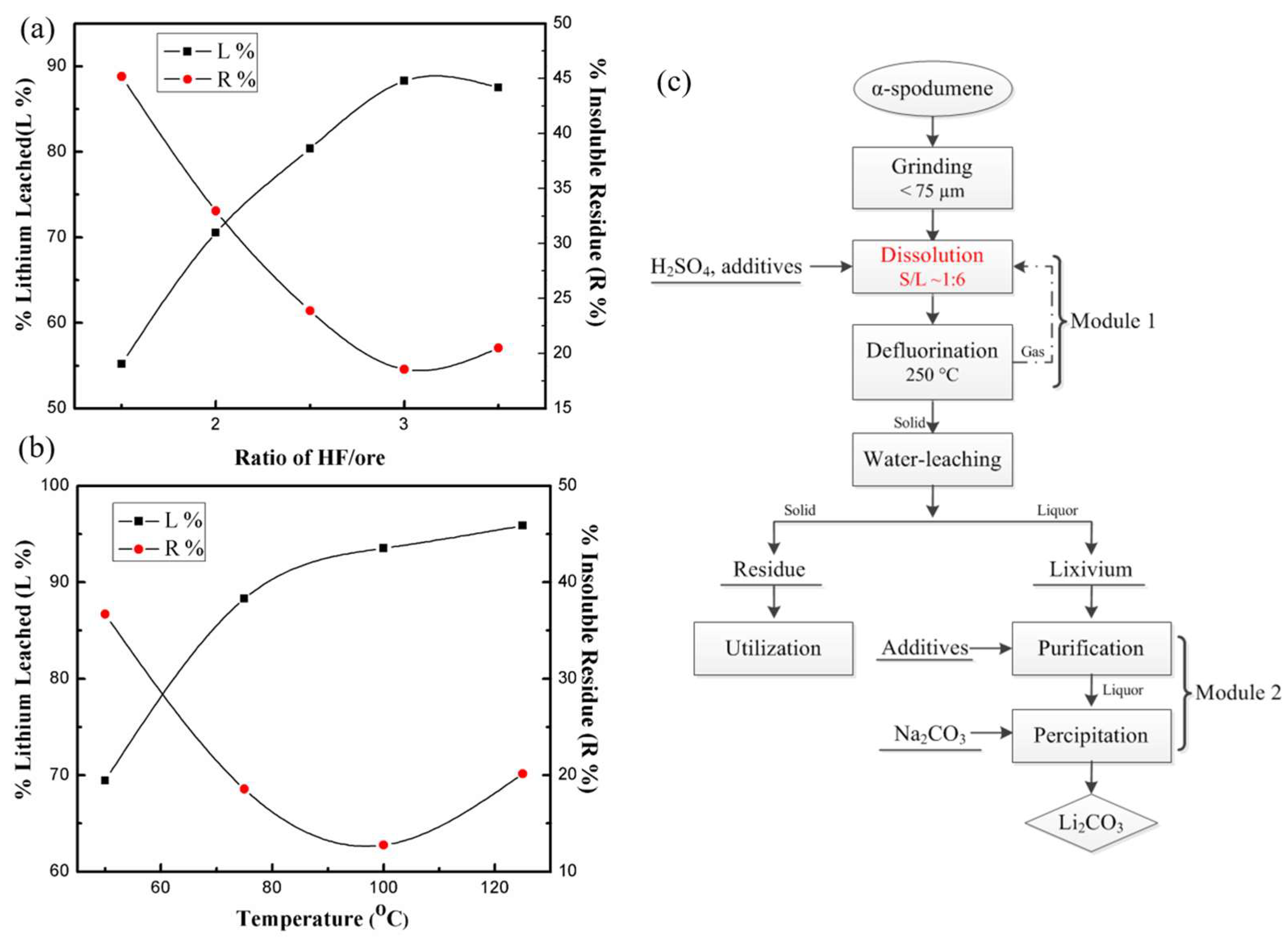
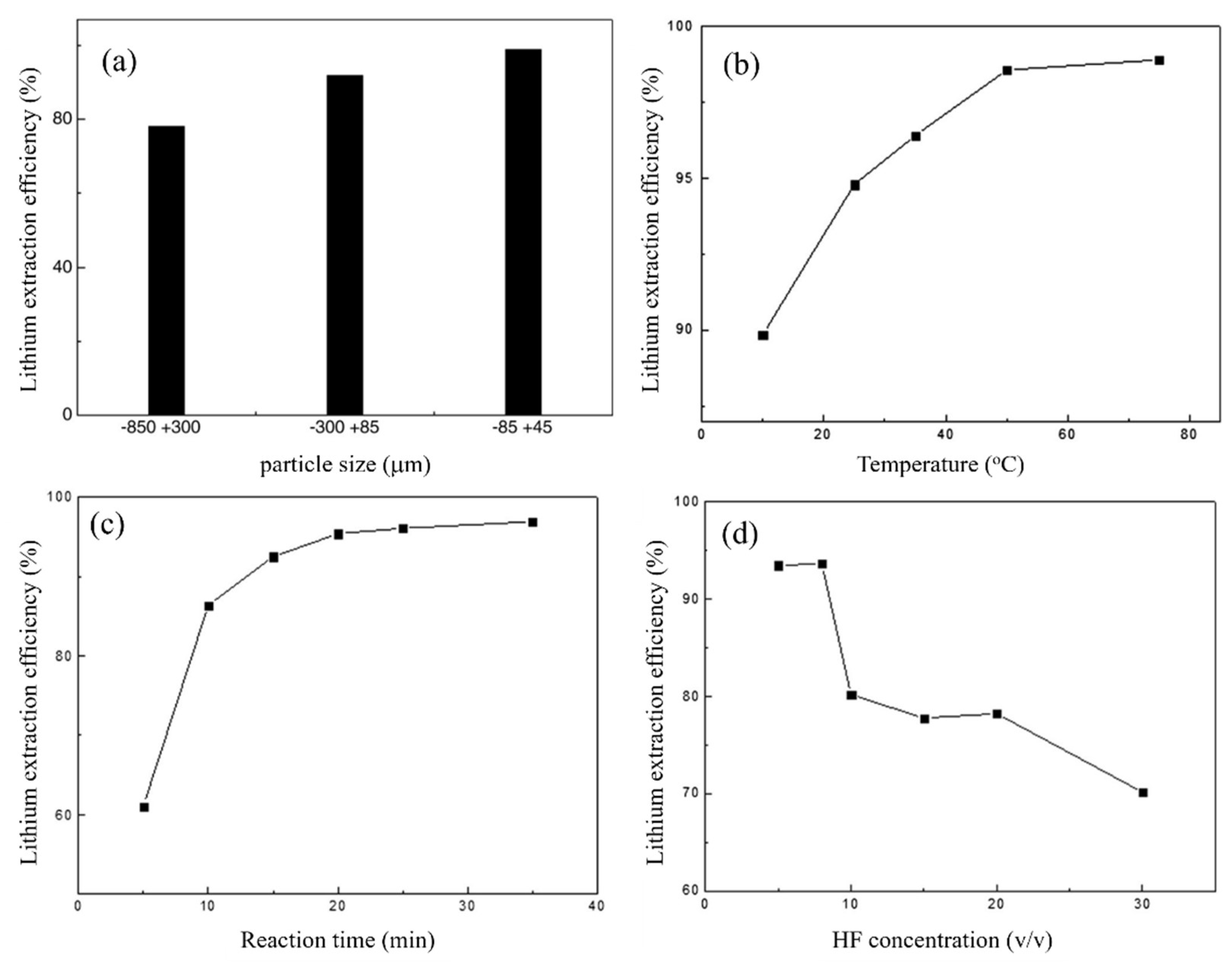
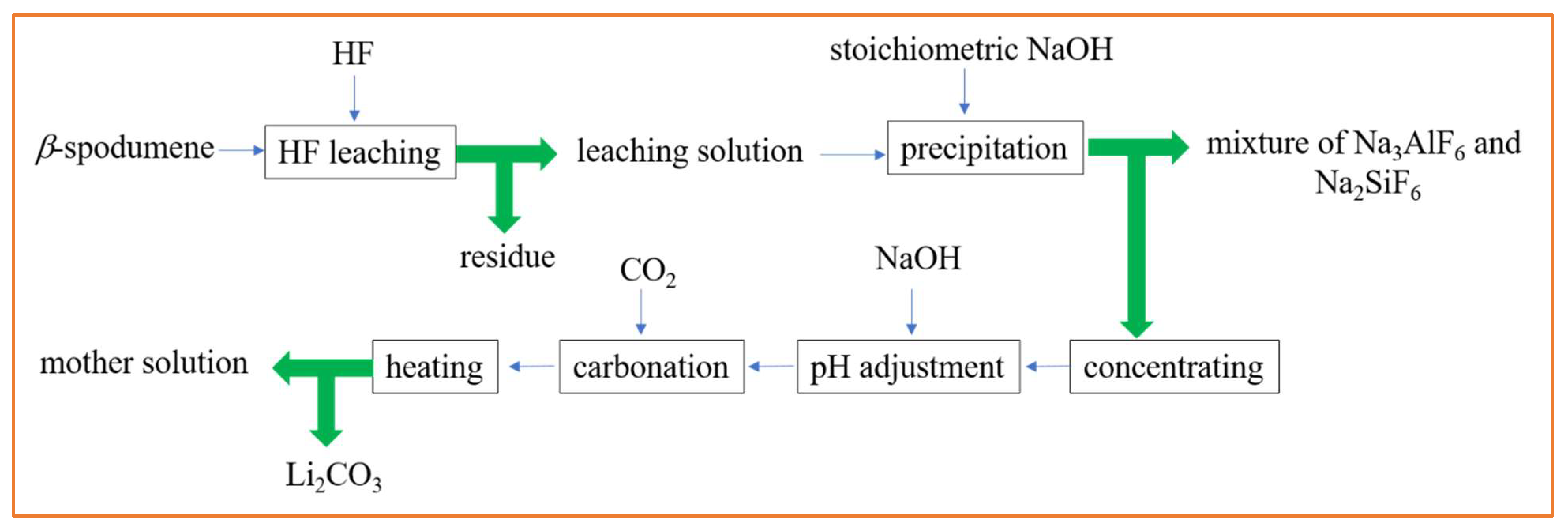


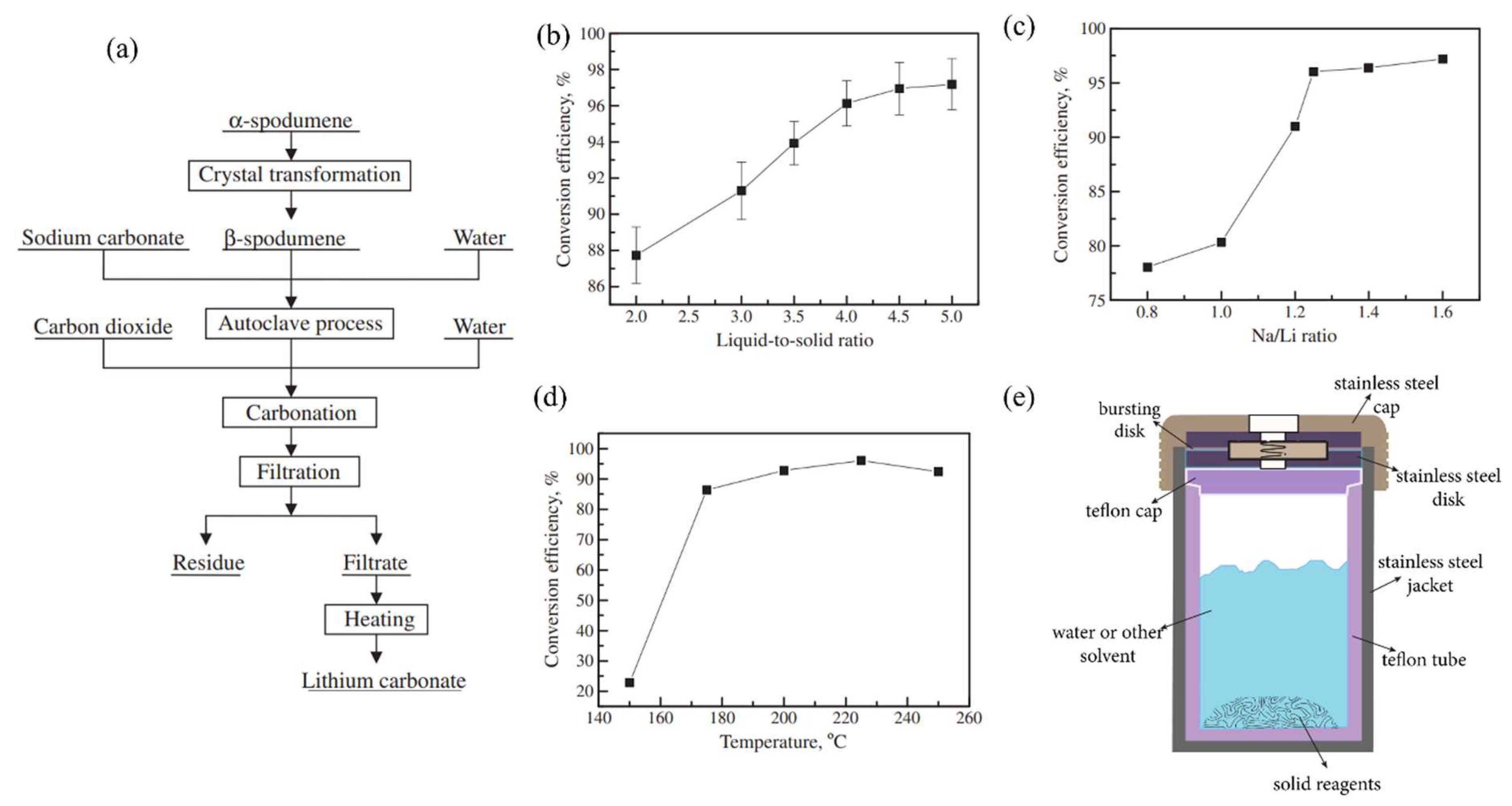
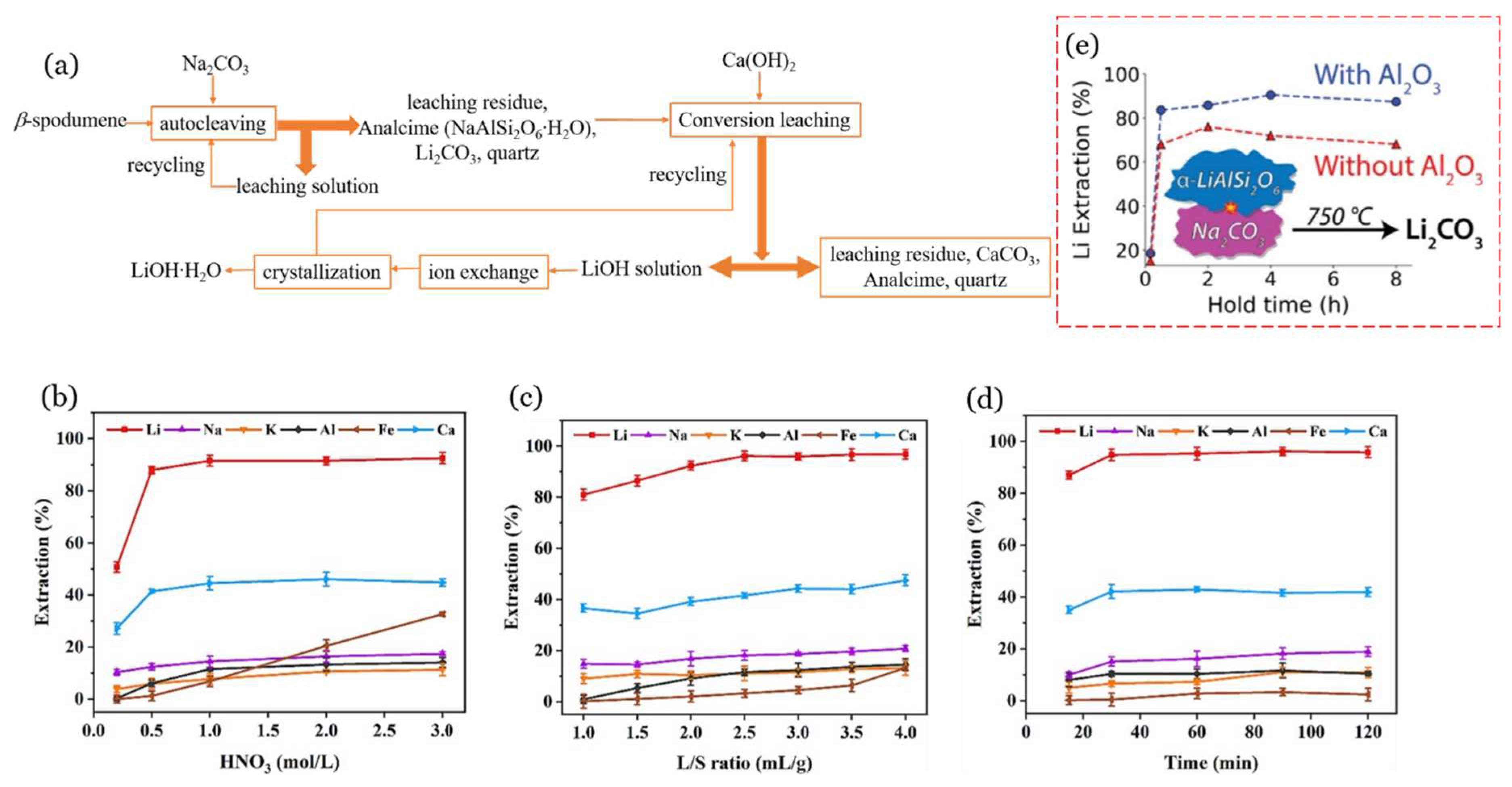
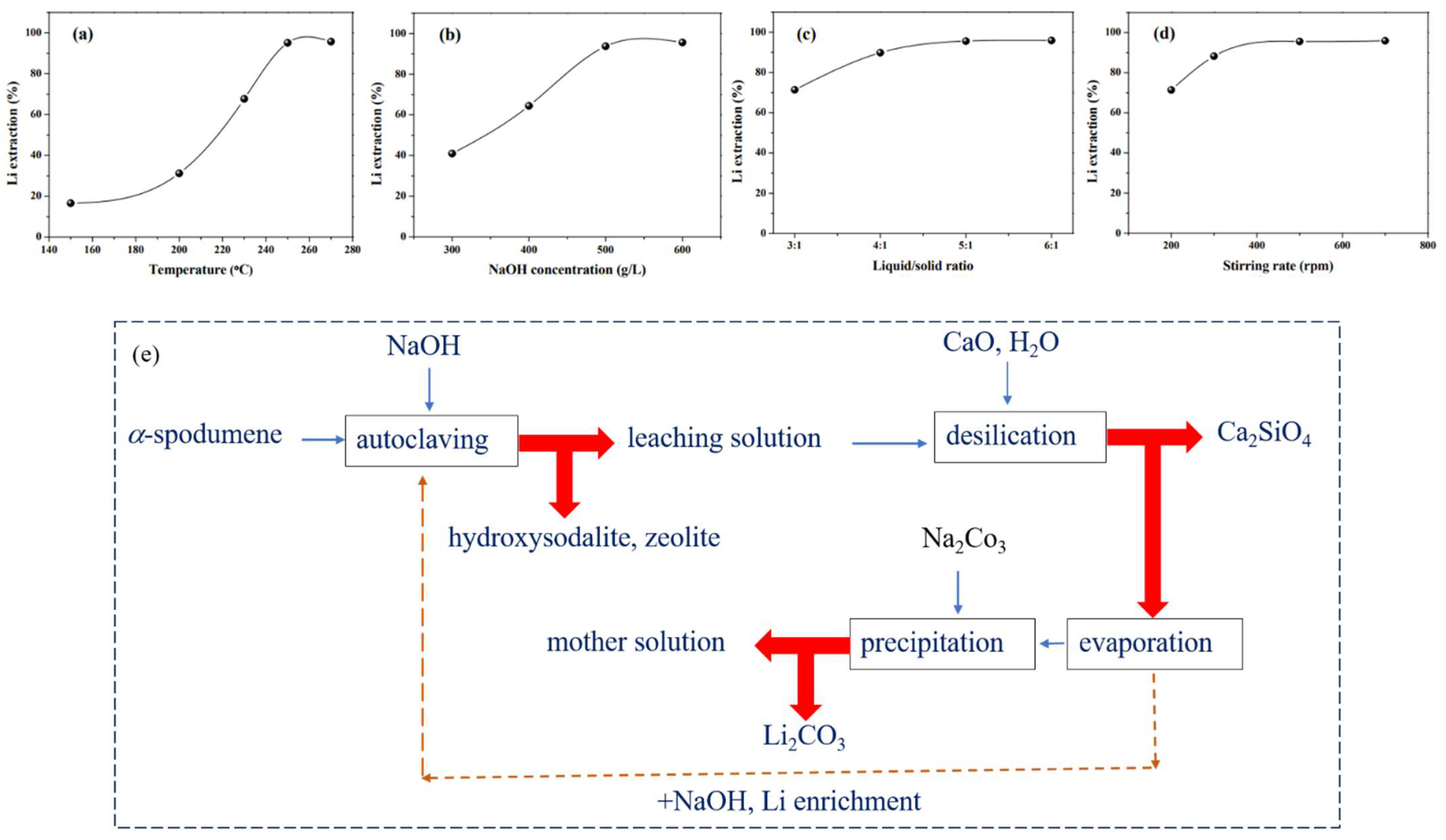

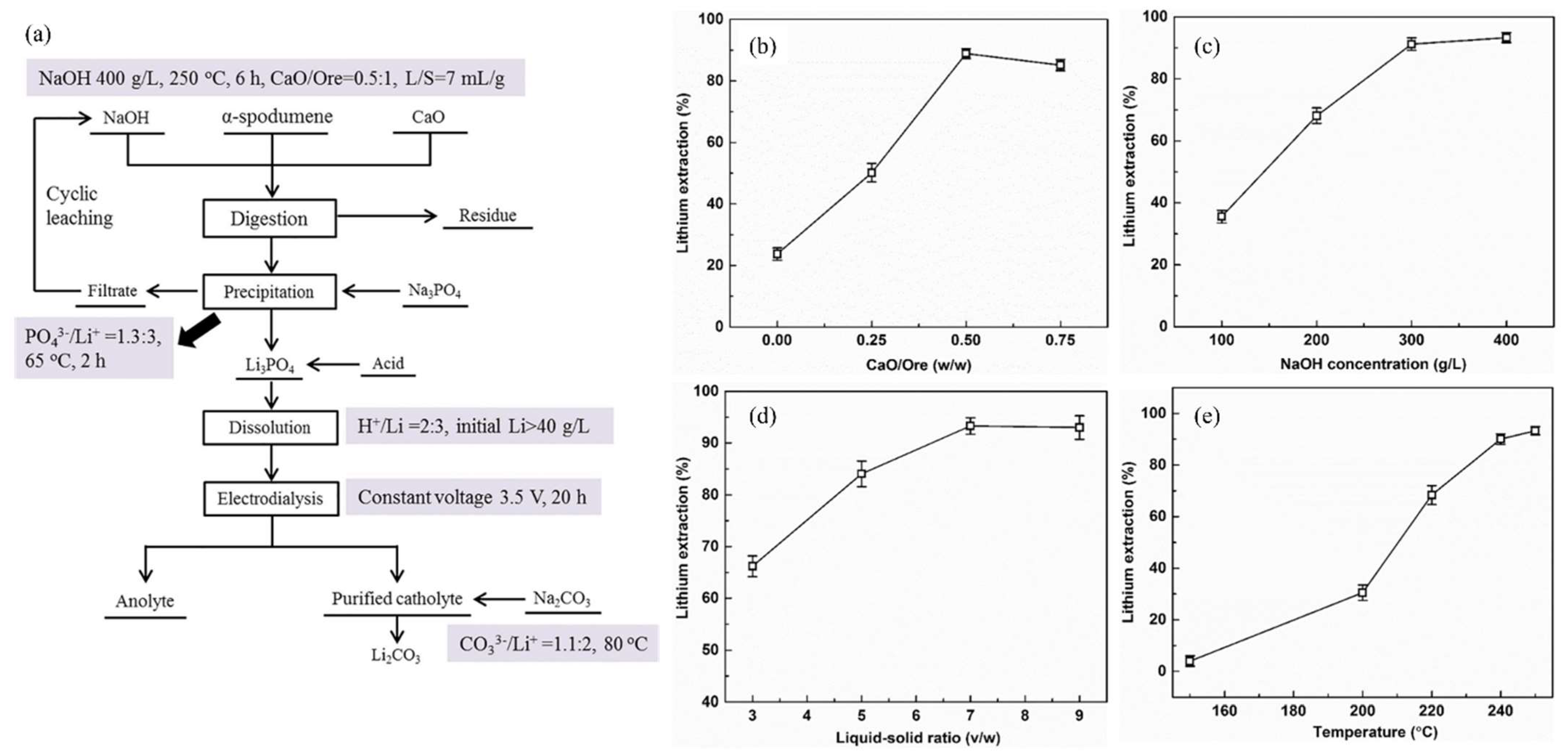


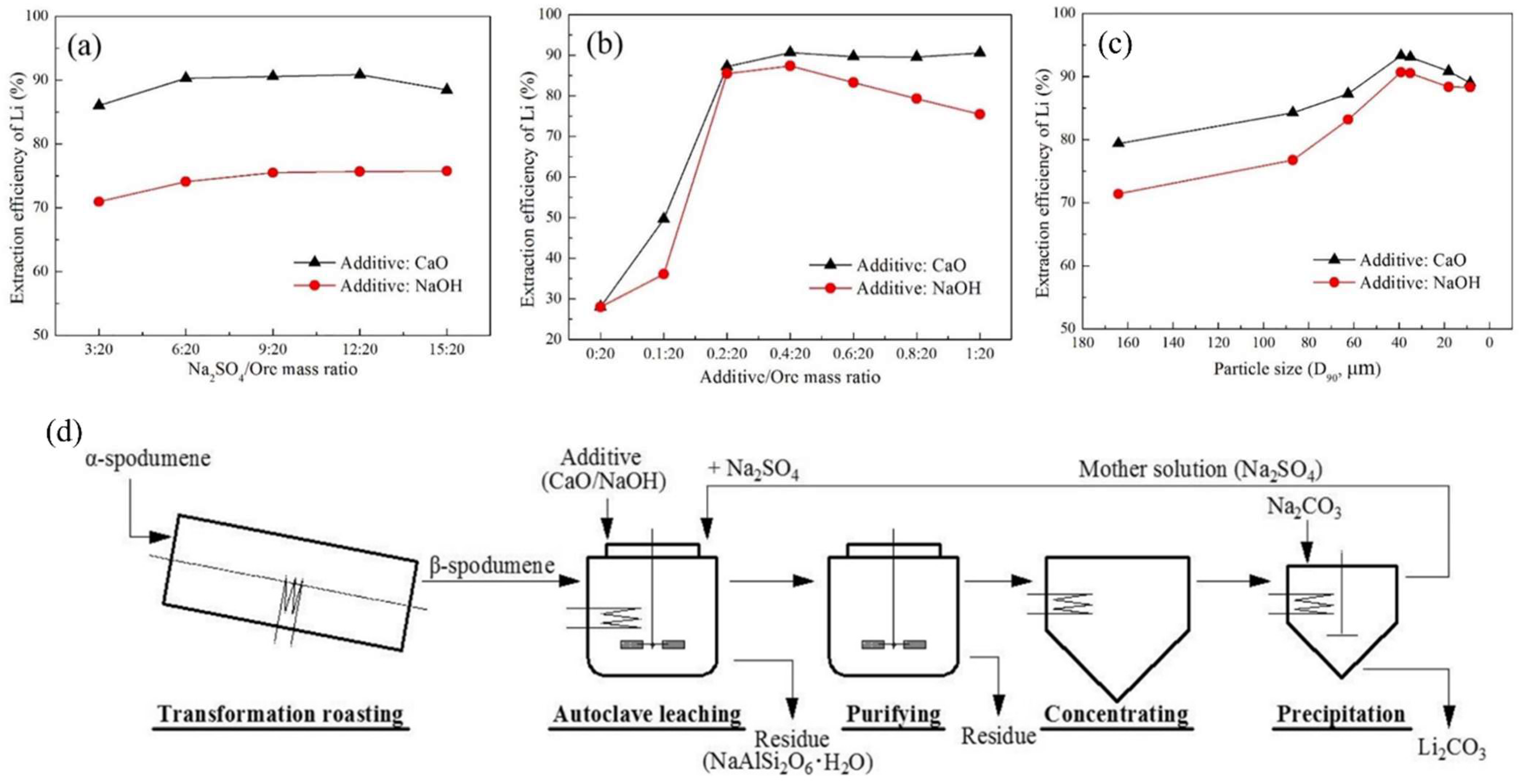
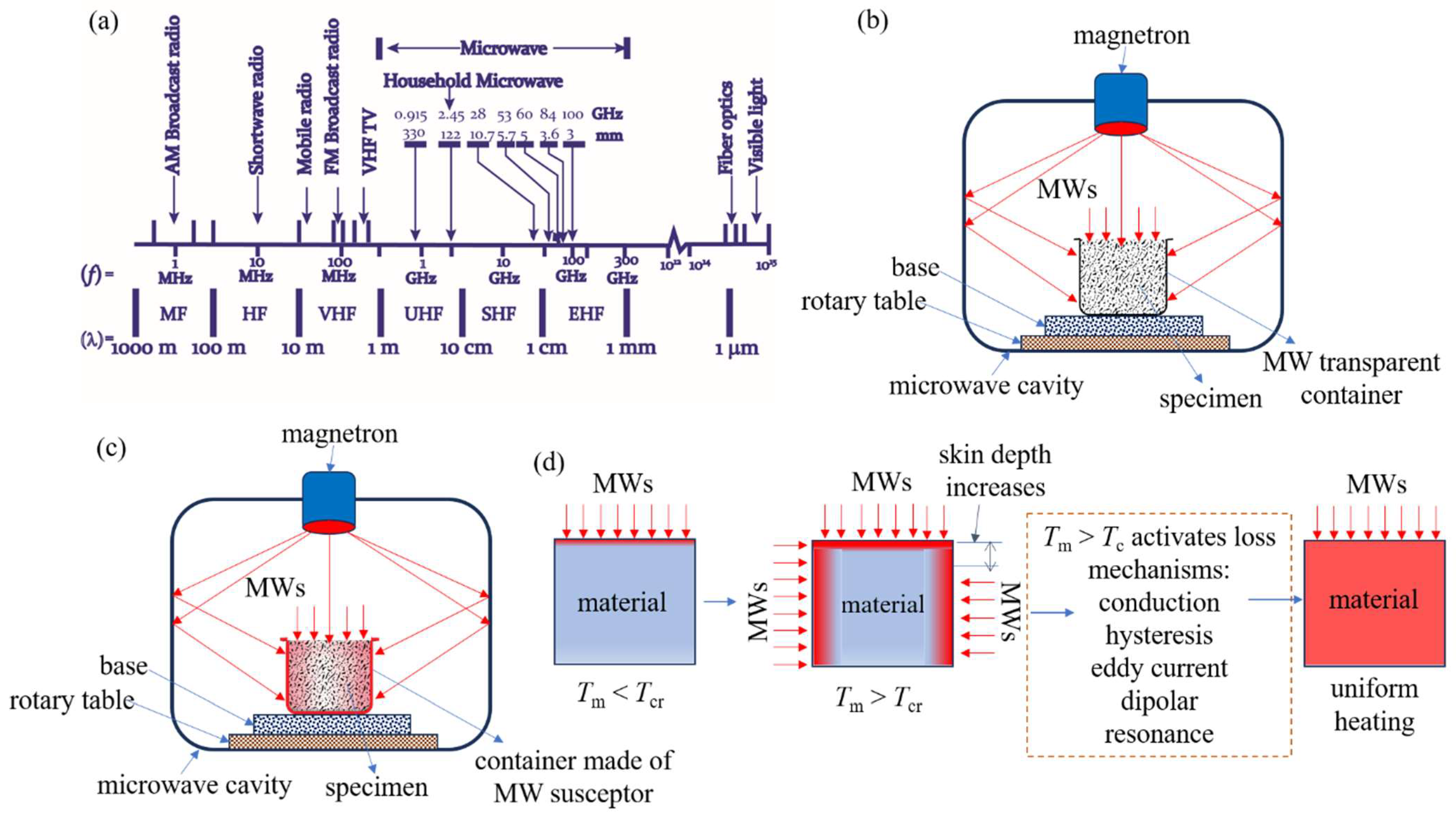



| Mineral | Formula | Theoretical Li Content (%) |
|---|---|---|
| Amblygonite | (Li,Na)AlPO4 (OH,F) | 4.73 |
| Bikitaite | LiAlSi2O6·H2O | 3.40 |
| Elbaite | Na(Li1.5Al1.5)Al6Si6B3O27(OH)4 | 1.11 |
| Eucryptite | LiAlSiO4 | 5.51 |
| Hectorite | Na0.3(Mg,Li)3Si4O10(OH)2 | ~1.93 |
| Jadarite | LiNaAlSiB2O7(OH) | 2.85 |
| Lepidolite | KLi2AlSi3O10(OH,F)2 | ~3.84 |
| Lithiophylite | LiMnPO4 | 4.43 |
| Montebrasite | LiAl(PO4)(OH) | 1 to 4 |
| Petalite | LiAlSi4O10 | 2.27 |
| Spodumene | LiAlSi2O6 | 3.73 |
| Triphylite | LiFePO4 | 4.40 |
| Zabuyelite | Li2CO3 | 18.79 |
| Zinnwaldite | KLiFeAl2Si3O10(F,OH)2 | 1.59 |
| Process | Experimental Conditions | End Product/Recovery % | Ref. |
|---|---|---|---|
| Acid | Roasting: ore/HF/H2SO4 ratio of 1:3:2 (g/mL/mL), at 100 °C for 3 h; water leaching at 50 °C | Recovery of Li: 95% | [47] |
| Calcined at 1025 °C, roasting with H2SO4 at 175 °C; leaching with H2O | Recovery of Li: 93%; 99.9% pure LiOH∙H2O | [76] | |
| Roasting (1050–1090 °C) and H2SO4 leaching; water leaching at 225 °C | 96% pure Li2CO3 | [57] | |
| Alkaline | Roasting Na2SO4/CaO or NaOH as additive/β-spodumene; leaching at 230 °C | Recovery of Li: 93.3% (CaO), 90.7% (NaOH) | [73] |
| Roasting with Na2CO3 at 550–650 °C for 30 min, followed by water leaching at RT | Recovery of Li: 92%; 98% pure Li2CO3 | [77] | |
| Hydrothermal alkaline treatment at 250 °C; α-spodumene + NaOH solution | Li2CO3 as product; Li recovery of 95.8% | [61] | |
| Autoclave alkaline treatment; α-spodumene + NaOH solution; acid leaching | Li2O extraction efficiency of 87.3% | [62] | |
| Autoclave alkaline treatment; α-spodumene + KOH solution | Li extraction efficiency could reach 89.9% | [63] | |
| Roasting (320 °C): α-spodumene + NaOH; acid leaching and water leaching; Na2CO3 roasting at 851 °C) | 88% for NaOH; 76% for Na2CO3 | [65] | |
| Roasting (1200 °C) with CaO; H2SO4 leaching | Leaching yield: 96.18% | [70] | |
| Chlorination | Chlorination (using CaCl2) at ~700 °C; water leaching | 90.2% Li extracted as LiCl at 900 °C | [54] |
| Roasting of β-spodumene with Cl2 at 1100 °C, 150 min | LiCl extracted at 1100 °C | [20] | |
| Roasting (550–1200 °C, 120 min) with MgCl2-CaCl2∙12H2O; leaching with H2O, HCl | LiCl extraction efficiency 50–90% | [56] | |
| Roasting (1000–1050 °C, 15–60 min) with KCl, NaCl; leaching with H2O/HCl | LiCl product; 85–97.5% | [78] | |
| Roasting (800–1200 °C, 180–720 min) with CaCl2; leaching reagent alcohol | LiCl product; 96.5–98.5% | [79] | |
| Roasting (250–750 °C) with NH4Cl; water leaching | LiCl product; 97–98% | [80] | |
| Carbonation | Roasting (100–205 °C, 60 min) with CaO + H2O; H2O leaching | LiOH product; 97% | [81] |
| Roasting (1000–1230 °C) with CaO + H2O; water leaching | LiOH product; 80% | [81] | |
| Roasting (150–250 °C, 10–120 min) with Na2CO3; water leaching | Li2CO3 product; 94% | [69] | |
| Autoclaving with Na2CO3 at 225 °C for 60 min; water leaching | Li2CO3 product; 70% 94% Li was extracted from β-spodumene | [57] | |
| Sulphation | Roasting (1000–1150 °C, 120–180 min) with CaSO4 + CaCO3; water leaching | Li2SO4 product; 85–90% | [82] |
| Roasting with Na2SO4 + CaO; leaching at 230 °C | Li2SO4 product; 93.3% | [73] | |
| Roasting (200–300 °C) with Na2SO4 + NaOH; leaching with Na2SO4 + NaOH | Li2SO4 product; 90.7% | [73] | |
| Fluorination | Roasting (600 °C) β-spodumene with NaF; leaching with HF | LiF product; 90% | [83] |
| HF + H2SO4/α-spodumene at 100 °C, 3 h | Li: 96% | [84] |
| Element/Mineral/ Compound | Time (min) of MW Exposure | T(K) | Element/Mineral/ Compound | Time (min) of MW Exposure | T(K) |
|---|---|---|---|---|---|
| Al | 6 | 850 | NiO | 6.25 | 1578 |
| C (amorphous, <1 μm) | 1 | 1556 | V2O5 | 11 | 987 |
| C (graphite, 200 mesh) | 6 | 1053 | WO3 | 6 | 1543 |
| C (graphite, <1 µm) | 1.75 | 1346 | Ag2S | 5.25 | 925 |
| Co | 3 | 970 | Cu2S (chalcocite) | 7 | 1019 |
| Fe | 7 | 1041 | CuFeS2 (chalcopyrite) | 1 | 1193 |
| Mo | 4 | 933 | Fe1−xS (phyrrhotite) | 1.75 | 1159 |
| V | 1 | 830 | FeS2 (pyrite) | 6.75 | 1292 |
| W | 6.25 | 963 | MoS2 | 7 | 1379 |
| Zn | 3 | 854 | PbS | 1.25 | 1297 |
| TiB2 | 7 | 1116 | PbS (galena) | 7 | 956 |
| Co2O3 | 3 | 1563 | CuBr | 11 | 995 |
| CuO | 6.25 | 1285 | CuCl | 13 | 892 |
| Fe3O4 (magnetite) | 2.75 | 1531 | ZnBr2 | 7 | 847 |
| MnO2 | 6 | 1560 | ZnCl2 | 7 | 882 |
Disclaimer/Publisher’s Note: The statements, opinions and data contained in all publications are solely those of the individual author(s) and contributor(s) and not of MDPI and/or the editor(s). MDPI and/or the editor(s) disclaim responsibility for any injury to people or property resulting from any ideas, methods, instructions or products referred to in the content. |
© 2024 by the authors. Licensee MDPI, Basel, Switzerland. This article is an open access article distributed under the terms and conditions of the Creative Commons Attribution (CC BY) license (https://creativecommons.org/licenses/by/4.0/).
Share and Cite
Nandihalli, N.; Chouhan, R.K.; Kuchi, R.; Hlova, I.Z. Aspects of Spodumene Lithium Extraction Techniques. Sustainability 2024, 16, 8513. https://doi.org/10.3390/su16198513
Nandihalli N, Chouhan RK, Kuchi R, Hlova IZ. Aspects of Spodumene Lithium Extraction Techniques. Sustainability. 2024; 16(19):8513. https://doi.org/10.3390/su16198513
Chicago/Turabian StyleNandihalli, Nagaraj, Rajiv K. Chouhan, Rambabu Kuchi, and Ihor Z. Hlova. 2024. "Aspects of Spodumene Lithium Extraction Techniques" Sustainability 16, no. 19: 8513. https://doi.org/10.3390/su16198513








